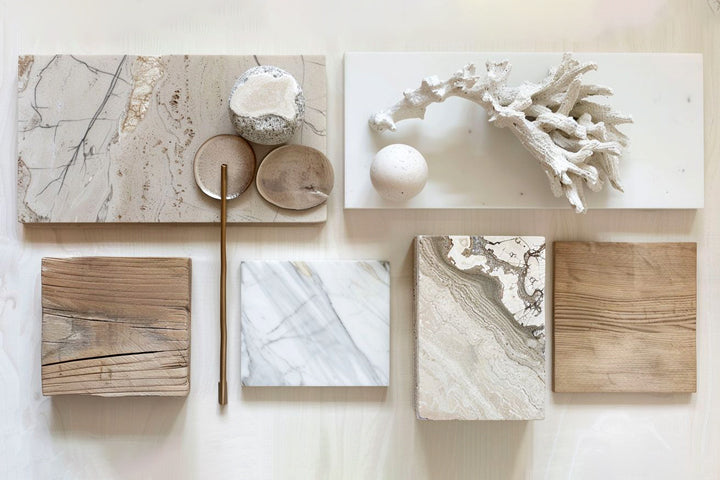Material Matters: The Essence of High-End Interiors
When it comes to luxury living, it’s not just the design that speaks; it’s the materials. The essence of a truly high-end interior lies in the thoughtful selection and pairing of materials that bring depth, richness, and character to a space. From marble that whispers timeless elegance to velvet that adds tactile indulgence, every material plays a role in shaping the mood and value of your home.
In this blog, we’ll explore why material matters in luxury design, the most sought-after finishes, and how you can incorporate them into your home to create interiors that feel refined, enduring, and unique.

Why Materials Define Luxury Interiors
Luxury design is not simply about expensive décor or ornate finishes; it’s about authenticity, craftsmanship, and longevity. High-end interiors often emphasise:
• Timeless appeal – Choosing materials like natural stone, hardwood, or brass ensures designs that never go out of style.
• Tactile richness – Luxe interiors engage more than just the eye; they’re designed to be felt through surfaces like silk, linen, and velvet.
• Durability – True quality materials not only look beautiful but also stand the test of time.
• Storytelling – Many materials, such as reclaimed wood or handwoven textiles, carry narratives of tradition, artistry, and heritage.
The Most Iconic Materials in High-End Interiors
Marble: A Symbol of Timeless Grandeur
Marble has been synonymous with opulence since ancient Rome. Today, it remains a staple in luxury homes, from countertops and fireplaces to sculptural tables. Each slab of marble is one-of-a-kind, with veining that makes it both a design statement and an artwork of nature.
Where to Use It: Kitchen islands, bathrooms, accent walls, coffee tables.
Pro Tip: Mix white Carrara or Calcutta with brass or matte black fixtures for a modern classic touch.
Brass & Gold Accents: Subtle Glamour
Brass and gold tones bring warmth and understated glamour to interiors. Whether in furniture trims, light fixtures, or cabinet handles, these accents elevate the design without overpowering it.
Where to Use It: Light fixtures, bar carts, mirror frames, door hardware.
Pro Tip: Opt for brushed brass instead of polished gold for a softer, contemporary feel.
Wood Wonders: From Teak to Walnut
Wood is the soul of classic interiors. Rich hardwoods like walnut, oak, and teak are timeless choices that add depth and grounding to any room. Beyond flooring and furniture, wood brings warmth to ceilings, walls, and even smaller décor details.
Where to Use It: Statement dining tables, sideboards, wall cladding, and flooring.
Pro Tip: Pair dark woods with lighter upholstery or rugs to balance richness with softness.
Velvet & Textiles: The Touch of Indulgence
Velvet has long been associated with luxury, royalty, and comfort. Its soft sheen and plush texture instantly transform a space into something sophisticated. Alongside velvet, silk, linen, and handwoven rugs also add layers of elegance.
Where to Use It: Sofas, lounge chairs, curtains, cushions, and bed headboards.
Pro Tip: Jewel tones like emerald green, sapphire blue, or deep burgundy in velvet create stunning focal points.
Glass & Mirrors: Modern Transparency
Glass plays a unique role in luxury interiors, adding transparency, depth, and light. When paired with metal or wood, glass feels both modern and timeless. Similarly, mirrors can expand a space visually while amplifying its grandeur.
Where to Use It: Coffee tables, partitions, pendant lights, and mirrored panels.
Pro Tip: Smoked or tinted glass can soften harsh reflections and create a moody, luxe vibe.
Stone Beyond Marble: Granite, Onyx & Quartzite
While marble dominates the conversation, other natural stones like onyx, granite, and quartzite also have a strong place in high-end interiors. Each material brings unique veining, durability, and visual drama.
Where to Use It: Bars, bathrooms, tabletops, and fireplace surrounds.
Pro Tip: Use onyx with backlighting for a dramatic luxury statement.
Metallic Finishes: Stainless Steel, Bronze & Chrome
Metals balance softness with strength in interiors. From sleek stainless steel to aged bronze, they bring structure, shine, and industrial chic to a space.
Where to Use It: Kitchen cabinetry, shelving, side tables, sculptural accents.
Pro Tip: Mixing metals (like bronze and chrome) creates depth and avoids a “matchy” look.

How to Blend Materials for a Cohesive Luxury Look
The art of high-end design lies in balance. Too much marble may overwhelm; too much wood can feel heavy. Here are some ways to harmonise materials:
• Contrast textures: Pair velvet upholstery with marble-topped tables.
• Balance warm and cool: Combine cool stone with warm woods.
• Add subtle metallics: Use brass or bronze sparingly to accentuate focal points.
• Play with scale: Mix large, statement slabs of stone with small, intricate details like brass handles.
Classic Meets Contemporary: The Modern Take on Luxe Materials
Luxury today is about blending the timeless with the modern. Classic elements like marble and velvet can be reinterpreted with minimalist furniture silhouettes, bold colour palettes, or contemporary lighting. This approach keeps interiors fresh, sophisticated, and liveable, never stiff or outdated.

Why Material Matters Most
In high-end interiors, design isn’t just about shapes or colours, it’s about the materials that carry the essence of luxury. When chosen thoughtfully, materials tell stories, enhance comfort, and ensure timeless beauty. Whether it’s marble underfoot, velvet to sink into, or brass details catching the light, it’s the materiality that transforms a house into a truly luxurious home.
Frequently Asked Questions for Home Materials
1. What materials define luxury interior design?
Marble, brass, rich hardwoods like walnut or teak, velvet, silk, glass, and natural stones are key markers of luxury interiors.
2. How can I mix classic and modern materials at home?
Balance is key. Pair classic marble or wood with modern accents, such as glass, chrome, or sleek lighting, to create a transitional look.
3. Are luxury materials always expensive?
Not always. Many high-quality materials, like engineered stone or premium veneers, offer the look and durability of luxury without the same price tag.
4. Which material is best for a luxury living room?
Velvet furniture, marble tables, and brass accents can work together to create a luxe yet comfortable living room design.
5. What’s trending in modern luxury interiors today?
Sustainable materials like reclaimed wood, eco-friendly textiles, and reinterpreted classics like matte-finished marble or brushed metals are shaping luxury homes today.
 CUSTOM DESIGN SERVICES
CUSTOM DESIGN SERVICES STORE FINDER
STORE FINDER
 TRACK ORDER
TRACK ORDER

